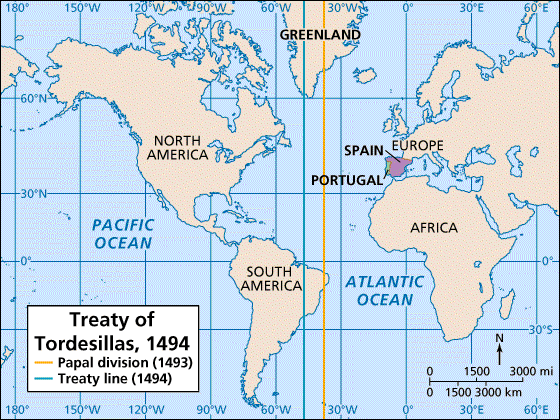The Treaty of Tordesillas
The Treaty of Tordesillas was an agreement between Portugal and Spain to divide ownership rights of New World territory between the countries. The treaty was originally agreed to by both countries on June 7, 1494, and went into effect in September of that year. Christopher Columbus had sailed under a Spanish flag when he traveled to the West Indies and back, but his first port of call in returning to Europe was in Lisbon, where met with Portugal’s King John II, who had declined to sponsor Columbus’s trip. The discovery of the new lands prompted the king to insist that all of that new territory belonged to Portugal, according to an existing treaty that Spain and Portugal had agreed to in 1479. Spain’s monarchs, Ferdinand and Isabella, didn’t agree, and all of the monarchs agreed to let the Spanish-born Pope, Alexander VI, decide.
Not happy with this arrangement, Portugal’s King John II negotiated with the Spanish monarchs. Portugal had more ships and military might at this time, so Spain was at somewhat at a disadvantage if the negotiations broke down and resulted in a fight. The result of those negotiations was a revised virtual north-south line, 270 leagues west of the original line, or 46°30′ W of Greenwich. The new line effectively gave Portugal control of what is now Brazil. In theory, the Treaty of Tordesillas and its subsequent renegotiated north-south line (known commonly as the Papal Line of Demarcation, when it was approved after the fact by the new pope, Julius II) divided North America and South America between Spain and Portugal. In reality, most of the New World was west of the line and so Spain ended up getting nominal authority over much more territory than Portugal did. Portuguese explorers and troops moved west of the line, but Spain didn’t object seriously enough to stop the Portuguese advance. As a result, Portugal gained control over all of what is now Brazil. Spain eventually got control of the rest of the New World. As time went on, however, other European powers, notably England and France, moved in with their own claims for settlement and ownership. These powers brought with them more money, wealth, and military might than either Portugal or Spain could effectively produce, if a disagreement became a war. Most of the English and French colonization were in North America (although both England and France claimed some lands in South America as colonies). In the first of the 19th Century, most of the Portuguese and Spanish colonies became independent. |
|
Social Studies for Kids
copyright 2002–2026
David White



 The result was a papal pronouncement (called a bull) that drew a virtual north-south line 100 leagues of the Cape Verde Islands. According to the papal bull, all lands west of the land would belong to Spain. The bull did not mention Portugal, however, and one interpretation of the papal bull could be that Spain then gained control of Portugal’s lands in Asia.
The result was a papal pronouncement (called a bull) that drew a virtual north-south line 100 leagues of the Cape Verde Islands. According to the papal bull, all lands west of the land would belong to Spain. The bull did not mention Portugal, however, and one interpretation of the papal bull could be that Spain then gained control of Portugal’s lands in Asia.
